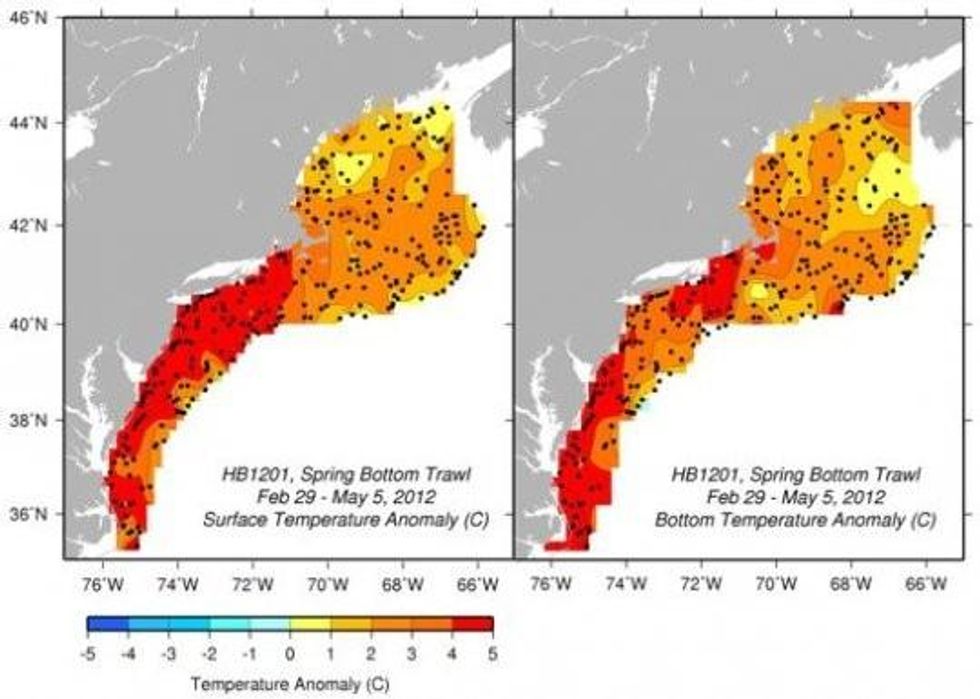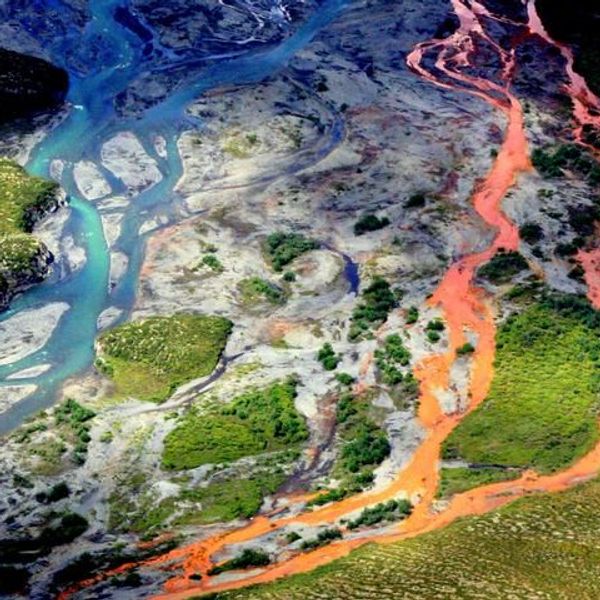NOAA: Record High Ocean Temperatures in North Atlantic
Ocean temperatures -- from the ocean bottom to the sea surface -- off the northeast coast of the U.S. have soared to their warmest ever, the National Oceanic and Atmospheric Administration (NOAA) said Tuesday.
The soaring temperatures follow other warming trends recently noted by the NOAA: we just experienced the fourth warmest August ever, the third warmest summer, and the warmest first 8 months of the year ever.

The northeast area documented by NOAA's Northeast Fisheries Science Center (NEFSC) is known as the Northeast Continental Shelf ecosystem, which comprises four major subareas: Gulf of Maine (GOM), Georges Bank (GB), Southern New England (SNE) and the Middle Atlantic Bight (MAB).
"A pronounced warming event occurred on the Northeast Shelf this spring, and this will have a profound impact throughout the ecosystem," said Kevin Friedland, a scientist in the NEFSC's Ecosystem Assessment Program, who said the warmer waters will have impacts on marine life, from plankton to whales. "Changes in ocean temperatures and the timing of the spring plankton bloom could affect the biological clocks of many marine species, which spawn at specific times of the year based on environmental cues like water temperature."
Atlantic cod has already been impacted, as it moves northeasterly in response to the warming waters.
The NEFSC recorded temperatures 11degF above historical average at the surface and more than 9degF above average at the bottom in the Delaware and Chesapeake Bays, while further north 3.6degF warmer than average temperatures were recorded for the bottom waters in the western Gulf of Maine.
"What is known is that things are changing, and we need to continue monitoring and adapting to these changes," stated Mike Fogarty, who heads the Ecosystem Assessment Program.
An Urgent Message From Our Co-Founder
Dear Common Dreams reader, The U.S. is on a fast track to authoritarianism like nothing I've ever seen. Meanwhile, corporate news outlets are utterly capitulating to Trump, twisting their coverage to avoid drawing his ire while lining up to stuff cash in his pockets. That's why I believe that Common Dreams is doing the best and most consequential reporting that we've ever done. Our small but mighty team is a progressive reporting powerhouse, covering the news every day that the corporate media never will. Our mission has always been simple: To inform. To inspire. And to ignite change for the common good. Now here's the key piece that I want all our readers to understand: None of this would be possible without your financial support. That's not just some fundraising cliche. It's the absolute and literal truth. We don't accept corporate advertising and never will. We don't have a paywall because we don't think people should be blocked from critical news based on their ability to pay. Everything we do is funded by the donations of readers like you. Will you donate now to help power the nonprofit, independent reporting of Common Dreams? Thank you for being a vital member of our community. Together, we can keep independent journalism alive when it’s needed most. - Craig Brown, Co-founder |
Ocean temperatures -- from the ocean bottom to the sea surface -- off the northeast coast of the U.S. have soared to their warmest ever, the National Oceanic and Atmospheric Administration (NOAA) said Tuesday.
The soaring temperatures follow other warming trends recently noted by the NOAA: we just experienced the fourth warmest August ever, the third warmest summer, and the warmest first 8 months of the year ever.

The northeast area documented by NOAA's Northeast Fisheries Science Center (NEFSC) is known as the Northeast Continental Shelf ecosystem, which comprises four major subareas: Gulf of Maine (GOM), Georges Bank (GB), Southern New England (SNE) and the Middle Atlantic Bight (MAB).
"A pronounced warming event occurred on the Northeast Shelf this spring, and this will have a profound impact throughout the ecosystem," said Kevin Friedland, a scientist in the NEFSC's Ecosystem Assessment Program, who said the warmer waters will have impacts on marine life, from plankton to whales. "Changes in ocean temperatures and the timing of the spring plankton bloom could affect the biological clocks of many marine species, which spawn at specific times of the year based on environmental cues like water temperature."
Atlantic cod has already been impacted, as it moves northeasterly in response to the warming waters.
The NEFSC recorded temperatures 11degF above historical average at the surface and more than 9degF above average at the bottom in the Delaware and Chesapeake Bays, while further north 3.6degF warmer than average temperatures were recorded for the bottom waters in the western Gulf of Maine.
"What is known is that things are changing, and we need to continue monitoring and adapting to these changes," stated Mike Fogarty, who heads the Ecosystem Assessment Program.
Ocean temperatures -- from the ocean bottom to the sea surface -- off the northeast coast of the U.S. have soared to their warmest ever, the National Oceanic and Atmospheric Administration (NOAA) said Tuesday.
The soaring temperatures follow other warming trends recently noted by the NOAA: we just experienced the fourth warmest August ever, the third warmest summer, and the warmest first 8 months of the year ever.

The northeast area documented by NOAA's Northeast Fisheries Science Center (NEFSC) is known as the Northeast Continental Shelf ecosystem, which comprises four major subareas: Gulf of Maine (GOM), Georges Bank (GB), Southern New England (SNE) and the Middle Atlantic Bight (MAB).
"A pronounced warming event occurred on the Northeast Shelf this spring, and this will have a profound impact throughout the ecosystem," said Kevin Friedland, a scientist in the NEFSC's Ecosystem Assessment Program, who said the warmer waters will have impacts on marine life, from plankton to whales. "Changes in ocean temperatures and the timing of the spring plankton bloom could affect the biological clocks of many marine species, which spawn at specific times of the year based on environmental cues like water temperature."
Atlantic cod has already been impacted, as it moves northeasterly in response to the warming waters.
The NEFSC recorded temperatures 11degF above historical average at the surface and more than 9degF above average at the bottom in the Delaware and Chesapeake Bays, while further north 3.6degF warmer than average temperatures were recorded for the bottom waters in the western Gulf of Maine.
"What is known is that things are changing, and we need to continue monitoring and adapting to these changes," stated Mike Fogarty, who heads the Ecosystem Assessment Program.

